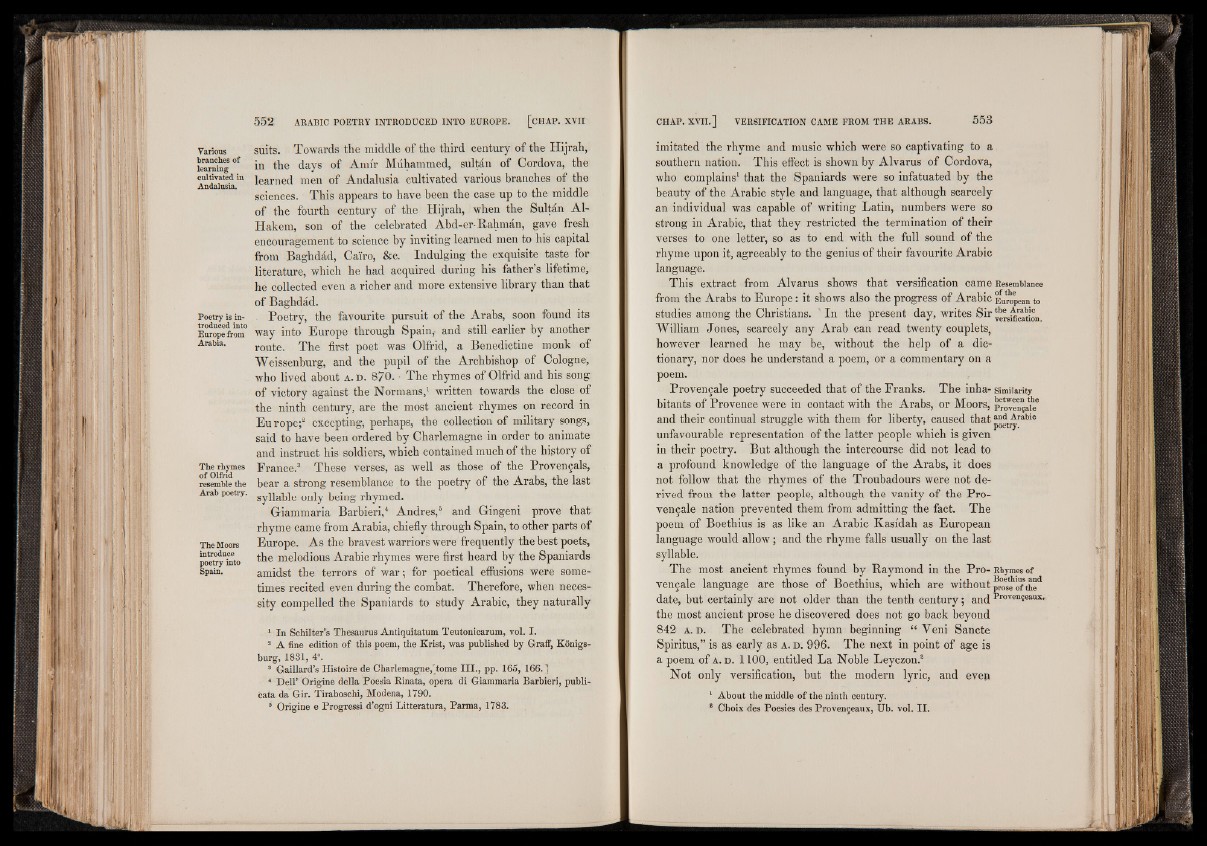
Various
branches of
learning
cultivated in
Andalusia.
Poetry is introduced
into
Europe from
Arabia.
The rhymes
of Olfrid
resemble the
Arab poetry.
The Moors
introduce
poetry into
Spain.
suits. Towards the middle of the third century of the Hijrah,
in the days of Amir Múhammed, sultán of Cordova, the
learned men of Andalusia cultivated various branches of the
sciences. This appears to have been the ease up to the middle
of the fourth century of the Hijrah, when the Sultán Al-
Hakem, son of the celebrated Abd-er-Rahmán, gave fresh
encouragement to science by inviting learned men to his capital
from Baghdád, Cairo, &c. Indulging the exquisite taste for
literature, which he had acquired during his father’s lifetime,
he collected even a richer and more extensive library than that
of Baghdád.
Poetry, the favourite pursuit of the Arabs, soon found its
way into Europe through Spain,- and still earlier by another
route. The first poet was Olfrid, a Benedictine monk of
Weissenburg, and the pupil of the Archbishop of Cologne,
who lived about a . d . 870. ■ The rhymes of Olfrid and his song
of victory against the Normans,' written towards the close of
the ninth century, are the most ancient rhymes on record in
Europe;2 excepting, perhaps, the collection of military songs,
said to have been ordered by Charlemagne in order to animate
and instruct his soldiers, which contained much of the history of
France.3 These verses, as well as those of the Provencals,
bear a strong resemblance to the poetry of the Arabs, the last
syllable only being rhymed.
Giammaria Barbieri,4 Andres,5 and Gingeni prove that
rhyme came from Arabia, chiefly through Spain, to other parts of
Europe. As the bravest warriors were frequently the best poets,
the melodious Arabic rhymes were first heard by the Spaniards
amidst the terrors of war; for poetical effusions were sometimes
recited even during the combat. Therefore, when necessity
compelled the Spaniards to study Arabic, they naturally
1 In Schilter’s Thesaurus Antiquitatum Teutoniearum, vol. I.
a A fine edition of this poem, the Krist, was published by Graff, Konigs-
burg, 1831, 4°.
3 Gaillard’s Histoire de Charlemagne/tome I I I ., pp. 165, 166.]
4 Dell’ Origine della Poesia Rinata, opera di Giammaria Barbieri, publicata
da Gir. Tiraboschi, Modena, 1790.
3 Origine e Progressi d’ogni Litteratura, Parma, 1783.
imitated the rhyme and music which were so captivating to a
southern nation. This effect is shown by Alvarus of Cordova,
who complains1 that the Spaniards were so infatuated by the
beauty of the Arabic style and language, that although scarcely
an individual was capable of writing Latin, numbers were so
strong in Arabic, that they restricted the termination of their
verses to one letter, so as to end with the full sound of the
rhyme upon it, agreeably to the genius of their favourite Arabic
language.
This extract from Alvarus shows that versification came Resemblance
from the Arabs to Europe : it shows also the progress of Arabic European to
studies among the Christians. ' In the present day, writes Sir »O'JûKH
William Jones, scarcely any Arab can read twenty couplets,
however learned he may be, without the help of a dictionary,
nor does he understand a poem, or a commentary on a
poem.
Provençale poetry succeeded that of the Franks. The inha- similarity
bitants of Provence were in contact with the Arabs, or Moors, provençale6
and their continual struggle with them for liberty, caused that p“^tryrabio
unfavourable representation of the latter people which is given
in their poetry. But although the intercourse did not lead to
a profound knowledge of the language of the Arabs, it does
not follow that the rhymes of the Troubadours were not derived
from the latter people, although the vanity of the Provençale
nation prevented them from admitting the fact. The
poem of Boethius is as like an Arabic Kasidah as European
language would allow ; and the rhyme falls usually on the last
syllable.
The most ancient rhymes found by Raymond in the Pro- Rhymes of
vençale language are those of Boethius, which are without prose'of thed
date, but certainly are not older than the tenth century; andProven5eaux.
the most ancient prose he discovered does not go back beyond
842 a . d . The celebrated hymn beginning “ Veni Sancte
Spiritus,” is as early as a . d . 996. The next in point of age is
a poem of a . d . 1 1 0 0 , entitled La Noble Leyczon.2
Not only versification, but the modern lyric, and even
1 About the middle o f the ninth century.
* Choix des Poesies des Provençeaux, Ub. vol. I I .